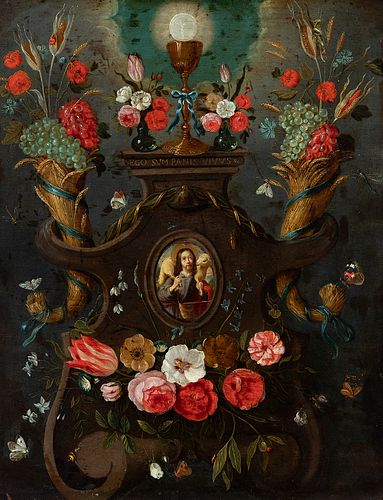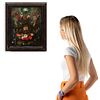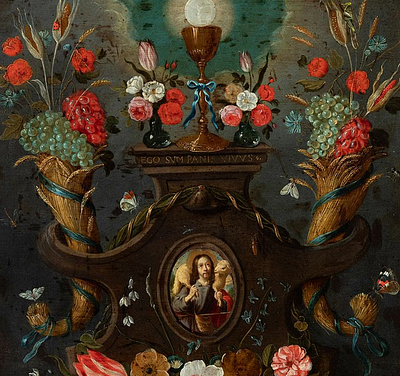Flemish school of the 17th century. "Orla de flores, con alegoría de la Eucaristía" (Flower border, with allegory of the Eucharist). Oil on copper.
Lot 38
About Seller
Setdart Auction House
Carrer Aragó 346
Barcelona
Spain
Setdart Subastas was born in 2004 and is currently the first online art auction in Spain with solidity, prestige and reliability guaranteed by our more than 60,000 users. Setdart has a young, dynamic and enterprising team ready to successfully manage the purchase and sale of art works through custom...Read more
Categories
Estimate:
EUR€9,000 - EUR€10,000
$9,375 - $10,416.67
Absentee vs Live bid
Two ways to bid:
- Leave a max absentee bid and the platform will bid on your behalf up to your maximum bid during the live auction.
- Bid live during the auction and your bids will be submitted real-time to the auctioneer.
Bid Increments
| Price | Bid Increment |
|---|---|
| EUR€0 | EUR€10 |
| EUR€200 | EUR€25 |
| EUR€500 | EUR€50 |
| EUR€1,000 | EUR€100 |
| EUR€3,000 | EUR€200 |
| EUR€5,000 | EUR€500 |
| EUR€10,000 | EUR€1,000 |
| EUR€20,000 | EUR€2,000 |
| EUR€50,000 | EUR€5,000 |
About Auction
By Setdart Auction House
Sep 21, 2021
Set Reminder
2021-09-21 10:00:00
2021-09-21 10:00:00
America/New_York
Bidsquare
Bidsquare : 21st September - ARAS JÁUREGUI Private Collection - Old Masters, 19th & 20th Century
https://www.bidsquare.com/auctions/setdart-auction-house/21st-september---aras-j-uregui-private-collection---old-masters-19th-20th-century-7429
Setdart Auction House sofia@setdart.com
Setdart Auction House sofia@setdart.com
- Lot Description
Flemish school of the 17th century. "Orla de flores, con alegoría de la Eucaristía" (Flower border, with allegory of the Eucharist). Oil on copper. It has an interior copper with a motif of the Good Shepherd. It has a frame from the end of the 19th century, following Dutch models. Measurements: 46 x 37 cm; 57 x 48 cm (frame). This work of devotional character is composed of two indistinct coppers that are joined to form a floral composition, where an allegory of the Eucharist is represented. That is to say, on the larger copper, there is another one superimposed in an oval format, in which the representation of the Good Shepherd is found, an iconography that has its roots in ancient Western art, specifically in the Muscophores of Ancient Greece. As for its meaning, the Good Shepherd is a biblical allegory, originally referring to Yahweh and later to Jesus Christ. The Good Shepherd is interpreted as God, who saves the lost sheep (the sinner). The theme appears in the Old Testament, and in the Gospels the same allegory is applied to Jesus as the Son of God. Returning to the larger copper, the protagonist is the architectural element where the border of Jesus as the Good Shepherd is depicted. In the upper part of this fanciful architecture we can read: EGO SUM PANIS VIVUS (I am the living bread), right on the cornice on which rests a chalice, with the sacred host on top, representative elements of the body and blood of Christ, so designated at the Last Supper. The scene is completed by two horns of plenty on the sides, a lower floral composition, and several butterflies that symbolise the passing of time and the temporality of life in this still life. This work follows a very popular tradition in 17th-century Baroque painting. Although, due to the importance of the flowers and fruit, it is possible to speak of a still life, the religious scene they frame means that it should be considered as part of a very common line of paintings in both the Spanish and Flemish schools.
- Shipping Info
-
In-house shipping available. Please inquire at admin@setdart.com.
-
- Buyer's Premium



 EUR
EUR CAD
CAD AUD
AUD GBP
GBP MXN
MXN HKD
HKD CNY
CNY MYR
MYR SEK
SEK SGD
SGD CHF
CHF THB
THB

















